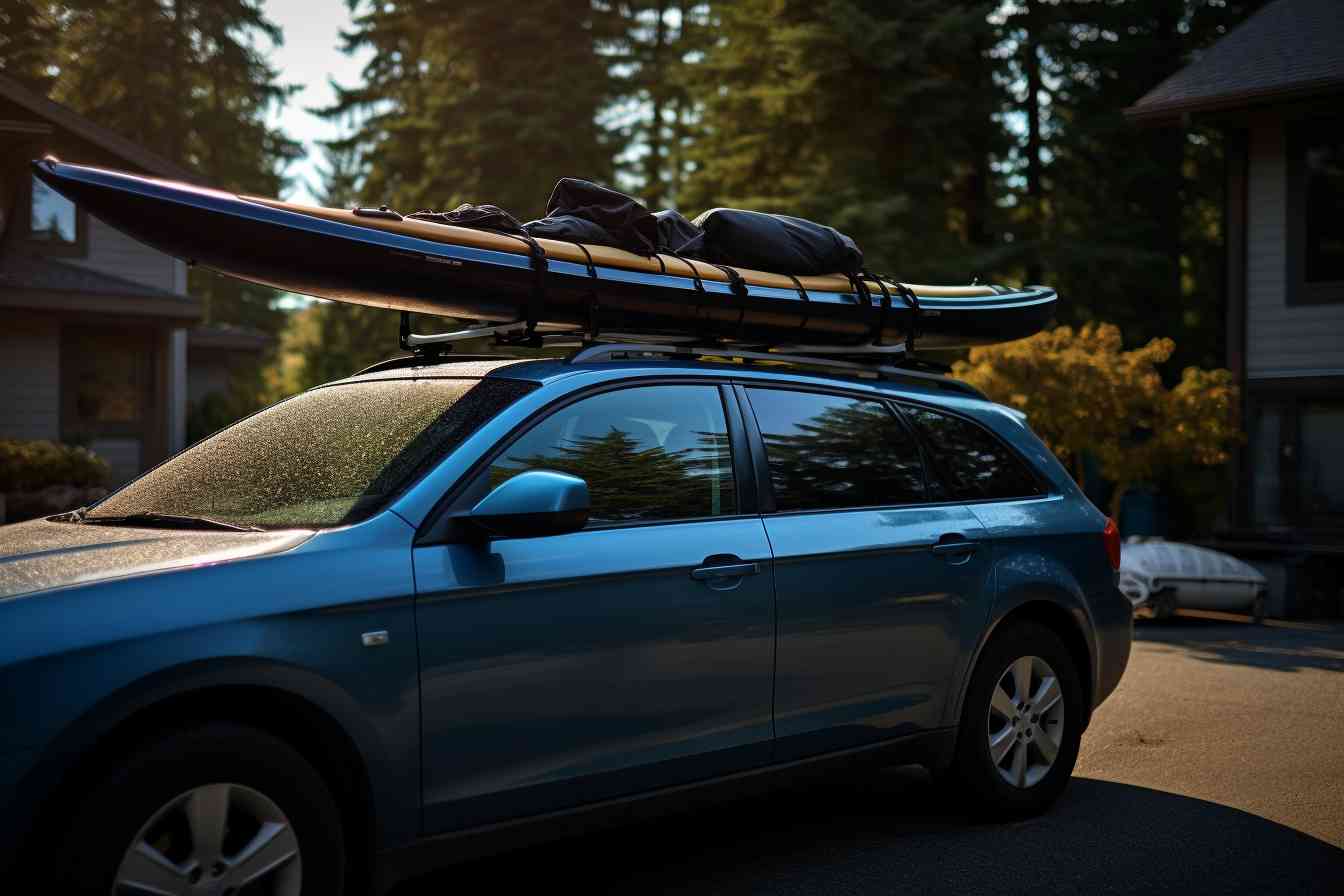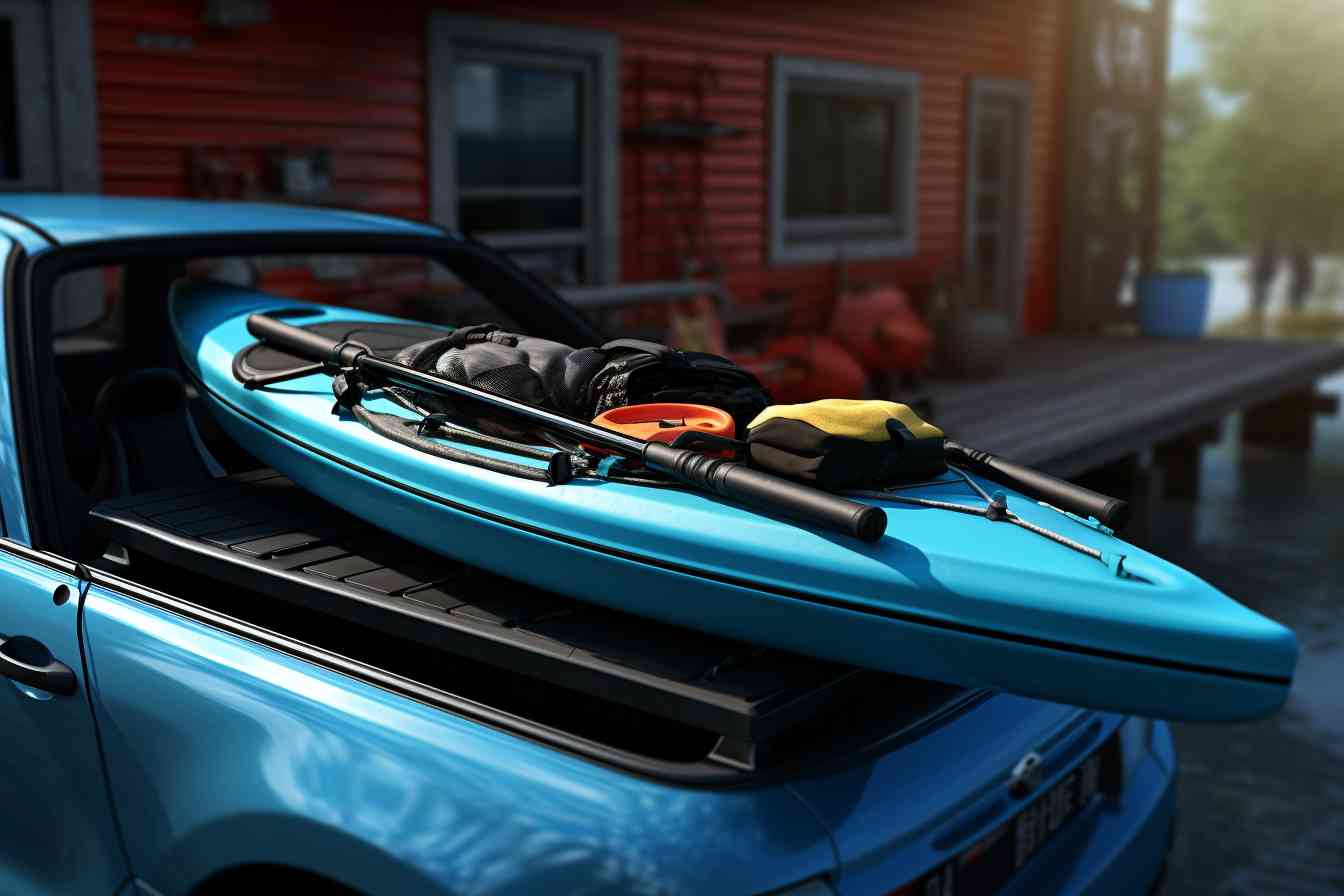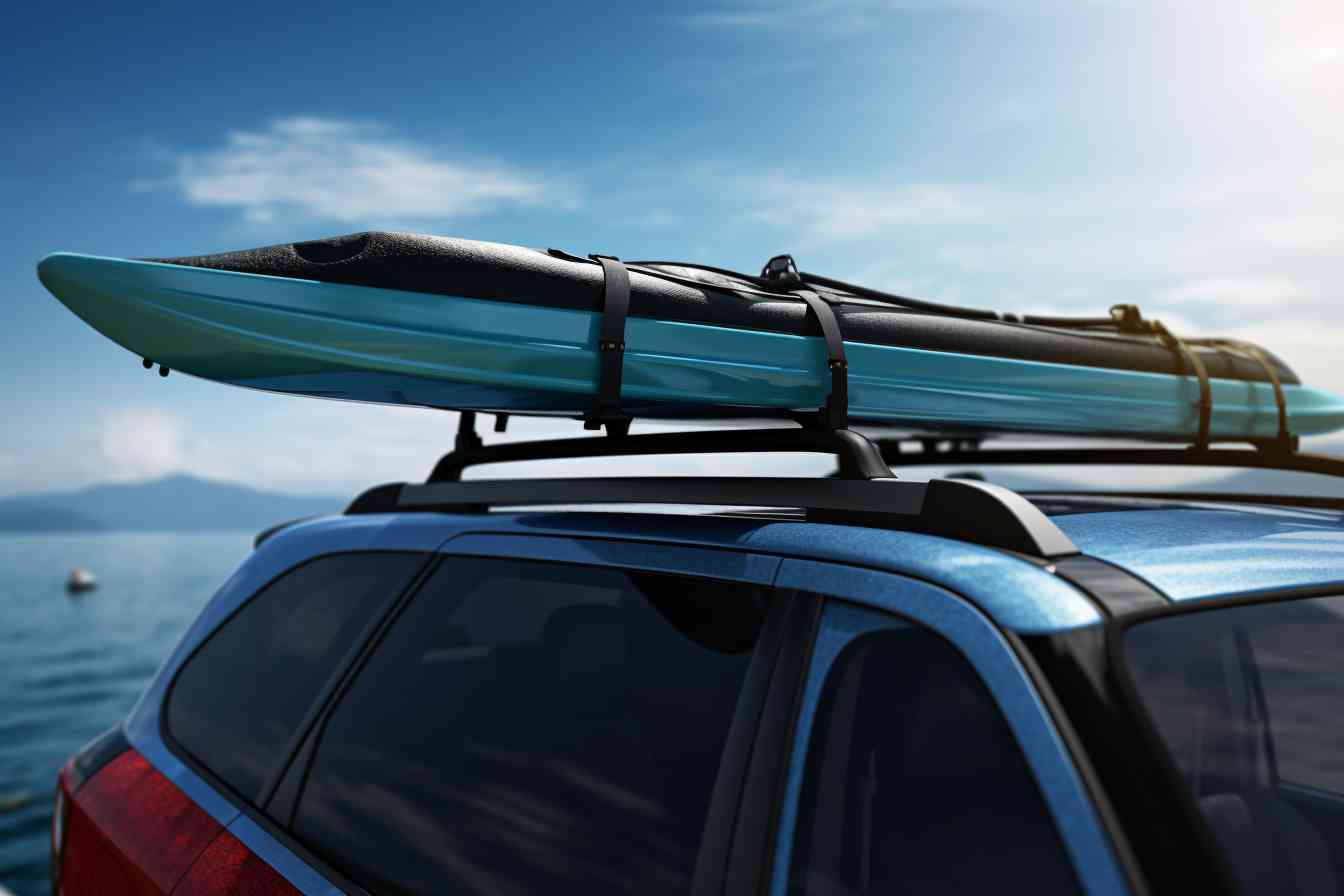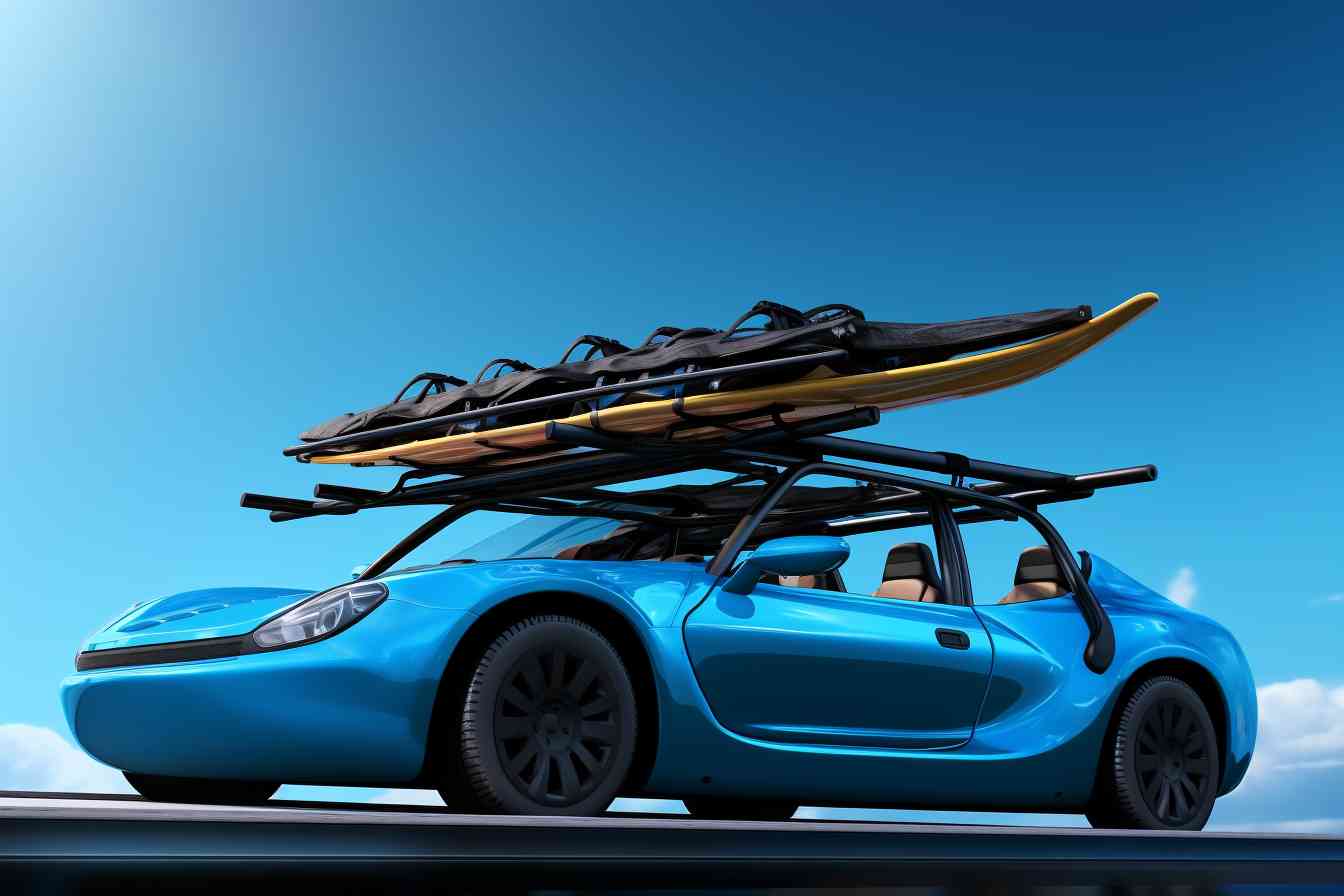Intro: Strap A Kayak To A Roof Rack

I gotta tell you, strapping a kayak to a roof rack always leaves me feeling as if I’ve just solved a tricky puzzle. The procedure can be a little complex, for sure, and it’s bound to get the adrenaline pumping a bit. But hey – that’s all part of the fun, isn’t it?
First things first, you gotta make sure that the roof rack is properly installed on your vehicle. Can’t stress that enough! Incorrect installation is an accident waiting to happen… Carefully follow the manufacturer’s instructions and once you’re done, double… or even triple-check that everything is nicely tightened and secured. Remember, the last thing you wanna deal with is a loose roof rack while you’re speeding down the highway!
Once the rack is secure, you’re gonna have to place the kayak on it. Now, this might sound simple, but you’d be surprised how many people fumble with this step… The kayak has to be upside down, with the cockpit facing upwards. This way, it’s not catching wind like a sail.
The ‘strapping’ part is where things get tricky. You’ve gotta strap the kayak at three crucial points – the front, the middle, and the rear. Ensure the straps are snug, but not overly tight – you don’t wanna squash your precious kayak now, do you? And here’s a pro tip: use bow and stern lines for extra stability. Remember, the objective is to make sure your kayak’s as stable as a rock!
I can’t tell you how many times I’ve seen people try to transport their kayaks improperly secured. It’s a dangerous game, not just for you, but for everyone else on the road around you. But with a bit of practice, and by following these steps, you’ll be able to safely strap your kayak to a roof rack without batting an eyelid! It may seem like a daunting task at first, but believe me – it’s all part of the adventure.
What Is The Best Way To Strap A Kayak To The Roof Rack?

Alright now, let’s get to the meat of the question – what’s the best way to strap a kayak to the roof rack? Well, friend, I’m here to guide you through the process. First things first, of course, you need the correct equipment. The essentials include a roof rack, some solid tie-down straps – we’re talking the good-quality kind, not the run-of-the-mill ones – a pair of bow and stern tie downs, and an assist strap if you’re loading on your own.
Alignment is the key to success in this operation. You gotta make sure your kayak is centered on the roof rack for stable transport. Ah, ease up! It’s exactly as complicated as it sounds. Position your kayak on its side and make sure the cockpit faces outwards– trust me, it’s the most aerodynamic position for transportation.
Now onto strapping, the heart of the operation if you will. Drape two straps over your kayak and place them so they align with the bars of the roof rack. Tighten the straps, but remember, you’re not trying to squeeze the life out of it. A firm, secure grip is what we’re after– nothing less, nothing more.
Here’s a nifty little tip – a touch on the bow and stern ties. You know, those pointy ends of the kayak? Those too need securing for safe transportation. Hook ‘em up from the end of the kayak to a solid point on your vehicle. But hey, watch out! Don’t attach them to plastic parts or it might end in a fiasco.
Remember, securing a kayak isn’t rocket science but it sure as heck requires attention to detail. So take your time, do it right and you’ll be just fine. Just remember – all it needs is a little patience and a lot of care. Trust me, your kayak (and the car behind you) will thank you!
How To Tie Down A Kayak On A J-Rack
Well, a solid knot is the key to a successful kayak transportation experience. Let’s talk about how to properly tie down a kayak on a j-rack.
- Firstly, you gotta place the kayak on the j-rack. Ensure that it is sitting flush against all points of the rack.
- Now, bring out your tie-down straps. Begin by threading the strap under the crossbar of your roof rack – make sure one end of the strap falls on each side of the kayak.
- Take the buckle end of the strap, crossing it over the kayak to the other side. The strap should be loosely draped over the kayak at this point.
- Feed the other end of the strap through the bottom of the buckle. Do this from underneath, creating a loop with the strap that surrounds the kayak and the roof rack’s crossbar.
- Now, tighten the strap by pulling down on the loose end. Ensure your kayak is secure but watch out – don’t over tighten. You don’t wanna warp your beloved kayak.
- It’s time to secure the loose end of the strap. You can wrap it around the roof rack and tie it using a basic knot or use a rubber band to keep it secure.
- Once done with the first strap, repeat the process using another strap on the other crossbar of our roof rack.
- Finally, give your kayak a good ol’ wiggle. Check to make sure it’s firmly secured and won’t shift during transportation.
- Oh, and one more thing. You might wanna tie a bowline from the bow and stern of your kayak to the front and rear of your car, respectively. This is just an extra precautionary measure, you know?
Sure, strapping a kayak to a j-rack might take a bit of time, but securing it properly is essential for safe transportation. So, take your time, follow these steps, and you’ll be all set for a trouble-free adventure!
How Do You Lock A Kayak To A Roof Rack?

So, you’ve got your kayak and roof rack all ready to go, but now you’re wondering… how exactly do you lock that bad boy in place? Well, stick with me, and I’ll tell you all you need to know!
First things first, put those straps to good use. Grab your kayak straps – they’re your new best friends. Take a strap and toss it over the roof rack’s crossbar. Take the other end and loop it through the handle of your kayak. Now, make sure to snug it up tight! You’d hate for your kayak to go swimming without ya, wouldn’t ya?
But wait, there’s more. You’re not just gonna leave it at that, right? Nope, we gotta get that thing locked down solid. So, your next move is to thread the strap through the roof rack’s other crossbar, wrap it back around the kayak and then pass it back through the crossbar again. Pull the strap taut and buckle it up. Now, your kayak is strapped in tight.
Did you get all that? Good! Now, it’s time to test the straps. Give your kayak a bit of a jiggle. If it shifts around, you need to tighten those straps. If not, you’re good to go!
Now, just for good measure, let’s add a lock. We can’t have someone just walking off with your kayak, can we? I mean, who does that? Anyway, find a lock that fits your roof rack and kayak handles. Thread the lock through the straps’ ends, lock it up, and voila! Your kayak is locked and loaded.
Well, there you have it, folks! Follow these steps, and you’ll have your kayak fast as a hare and secure as a bank. Hope you find this info useful and remember, always strap and lock your kayak before you hit the road. Happy paddling!
How To Strap A Kayak To A Car Without Roof Rack
Whoa there, you’re in a bit of a pickle, huh? Need to strap a kayak to your car, but you’re caught without a roof rack. No worries my friend, I’ve been there and navigated that choppy water – now it’s your turn. Let’s walk through this together, step by step.
-
Clear the Deck: Before anything else, you gotta make sure the roof of your vehicle is spic and span. Any dirt or grit can scratch your car as well as potentially harm the hull of the kayak, and we don’t want that, right?
-
Cushion the Blow: Use something soft, like foam blocks, to buffer between the kayak and your car’s roof. This protects both your car and your kayak from any damage that could be caused by friction or sudden jolts.
-
Lift with your Knees: You’re gonna bind that kayak onto the car solo? If so, remember to lift with your knees, not your back. If there’s another person around who can lend a hand, so much the better!
-
Positioning is Key: Ensure that the kayak is centered, both in terms of length and width. This gives you an even distribution of weight and prevents your car from tilting on one side while driving.
-
Secure the Bow and Stern: Use tie-down straps to secure the front (bow) and back (stern) of the kayak. Thread the straps through the carrying handles or around the body of the kayak, if no handles are available.
-
Cross Straps: Once your bow and stern are secured, it’s time for the cross straps. Wrap them over the top and around the sides of the kayak, and fasten them inside your car, through the doors or windows.
-
Is it Tight? Check that the straps are tight and holding the kayak securely, but not so tight that they’re damaging the hull. You can check this by attempting to relocate the kayak. If it slides around, you gotta knuckle down and secure it some more.
-
Final Check: Once everything’s strapped in, take a step back and give it a good once over. It may seem overkill, but it’s always better to spot potential problems before you’re halfway down the road.
Remember, no shortcuts with safety, and you’ll be out on the water in no time! Happy paddling!
Can A Roof Rack Hold A Kayak?

Well, well – here’s a question I get asked all the time! “” As a paddling enthusiast, I can yell a definite “Yes!” from the rooftop – pun intended. But, hold your horses, that doesn’t mean you can just sling your kayak up there without a care in the world.
Roof racks are specifically engineered to bear loads – that includes your precious kayak. But it wouldn’t hurt to first check the weight limit on your specific roof rack. Most of them can handle the weight of a standard kayak, which usually clocks in anywhere around 35 to 75 pounds. However, if your kayak is particularly hefty, or if you’re planning to cart a couple of them around, you’ll want to ensure that your roof rack can handle it.
Now, the weight’s not the only the only thing that’s matter, there’s also the size to consider. A roof rack can only hold a kayak securely if the kayak’s dimensions are suitable. So make sure your kayak will fit snugly, neither too taut, nor too loose.
Securing your kayak with the appropriate straps is also imperative. These straps must be fastened properly, ensuring your kayak is secure and can’t move about freely.
I must stress here – do remember that securing a kayak on top of your car involves more than just tying it down. I’d recommend using special kayak carriers that are designed to attach to roof racks, these ensure your kayak is carried safely and securely. Plus, they make it a cinch to load and unload your kayak.
So, to answer your question – your roof rack can, indeed, hold a kayak. But be smart about it! Heed these tips and make certain your next kayak transportation is a smooth sailing – or should I say, smooth driving?
How To Tie A Kayak To A Roof Rack With Ratchet Straps
Alright, so you’re all set for a day on the water and the only thing stopping you from sailing away is getting that kayak securely on your vehicle’s roof rack. The simple task could quickly become a stumbling block if you’re not sure how to do it!
-
First thing’s first, you’re going to need to gather all the necessary equipment. I’m talking about a couple of ratchet straps, your kayak obviously, and perhaps some padding for your vehicle’s roof rack if it doesn’t already have some protection. Who wants a scratched car, right?
-
Now that you’ve got all your gear, position your kayak onto the roof rack. It’s most optimal to place it upside down. Just remember, slow and steady does it!
-
Next, feed the strap under the rack on one side of the kayak. Then pull one end of the strap over the kayak. The strap should now go under the rack on the opposite side.
-
Lead the end of the strap that you just pulled under the rack back over to the first side and up through the ratchet. Make sure when you’re doing this, the strap isn’t twisted; otherwise it’ll be an absolute pain to tighten and loosen.
-
Pull on the loose end of the strap to tighten it. Just be careful not to pull too hard – we don’t want to damage the kayak or the rack. Your mantra here should be “secure, not squeezed”.
-
Once the strap is nice and firm, give the ratchet lever a few good tugs until the strap is snug. This is the part that’s going to keep the kayak firmly attached to the roof rack, so make sure it’s tight.
-
And lastly, lock the ratchet to hold the strap in place. There you’re almost done! Just make sure to tie off the loose end of the strap so it doesn’t flap around while you’re driving.
-
Repeat the process for every point where the rack crosses the kayak. I’d recommend at least two points – one near the front and one near the back of the kayak.
-
Finally, check everything. Give the kayak a good wiggle to see if it’s securely in place. If it budges, you haven’t done something right and you need to troubleshoot.
And there you have it, folks! Remember, practice makes perfect, so don’t get disheartened if you struggle the first time around. The more you do this, the easier it’ll become. It’s one step forward to enjoying your kayaking journey. Happy strapping and safe travels!
How Do You Lift A Kayak Onto A Roof Rack By Yourself?
Hey there champ, a quick pep talk here: lifting a kayak onto a roof rack, single-handedly, might seem like an Herculean task, but guess what – it isn’t! Just remember, where there’s a will, there’s a way. Now let me guide you through it, okay?
Begin with positioning the kayak parallel to your vehicle, its bow facing towards the front of your car. Using your leg for support, lift the stern of the kayak – this bit might require a bit of effort, but trust me, nothing you can’t handle.
Next up, align the kayak to the edge of the roof rack. Make sure to maintain the balance – just like life, right? Now gently push the kayak up onto the rack, using your strength effectively rather than forcefully – think of it as a gentle nudge.
When the kayak is halfway up the roof rack, go to the other end of the kayak. Gradually, push it up until it’s completely on top of the roof rack. Take a moment here, catch your breath. You’ve done well!
Now it’s time to secure your kayak to the roof rack. Use ratchet straps and pass them over the kayak and underneath the roof rack – cross them like an X for a secure fit. Pull them tight, but remember, not excessively to avoid damaging the kayak. Do a final walk-around and ensure the kayak is secure. And voila! You’ve successfully managed it on your own.
Remember, it’s vital to ensure the kayak’s absolutely safe before embarking on your journey. We wouldn’t want any unexpected surprises now, do we? Practice makes perfect, so don’t be disheartened if you struggle initially. Keep at it, and you’ll be strapping your kayak on your own in no time. You’ve got this!
How To Put Kayak On Roof Rack By Yourself
Oh boy, nothing quite pumps up the adrenaline like getting ready for a fun day on the water, huh? But first things first, let’s get that kayak up on the roof rack. It might seem a touch intimidating at first, but don’t fret—I’ve got a step-by-step guide for you right here.
- The very first thing you need to do is position your roof rack in the right place. Your roof rack should ideally be parallel to your vehicle’s doors. This will ensure stability during the drive.
- Next up, lift your kayak. To do this, grab one end of the kayak and lift it onto the back edge of your roof rack. Remember, safety first. Avoid straining yourself by trying to lift the kayak all at once.
- Carefully start sliding your kayak up onto the roof rack. Keeping your movements slow and steady will help prevent any accidental damage to your vehicle.
- Once the kayak is on the roof rack, make sure it’s centered. The kayak should be sitting snugly on the roof rack with equal amounts of overhang on both sides. Adjust the kayak as needed.
- Time for the straps. Take one and toss it over your kayak. Make sure it’s not twisted; you want it to sit flat against the kayak’s surface.
- Run the strap under the roof rack’s crossbar on one side, then back over the kayak. Repeat on the other side of the kayak. Your strap should now form a loop.
- Fasten the strap securely, but don’t over-tighten. You want to make sure your kayak won’t move during the drive, but over-tightening could potentially damage your kayak. Find that sweet spot.
- Repeat the process with another strap at the other end of the kayak. Two straps are usually enough to ensure a secure fit – one towards the front and one towards the rear.
- Once your straps are secured, your kayak should be safe and secure. Just to be safe, give it a good shake. If it wobbles, tighten your straps a bit more.
- And hey presto—you did it. Your kayak is ready for the ride.
Isn’t the feeling of accomplishment grand? Now that you’ve got the knack of it, you’ll be more than ready to strap your kayak onto your roof rack and head off next time the water calls your name!
Final Verdict
Well, now we’ve fully circled around back to where we began – me shedding light on strapping a kayak to a roof rack. Now, doesn’t it seem like a piece of cake? If you’ve been tailing me from the start, you must have had a few enlightening moments, right?
I must say, it’s a tad bit hard to bid adieu to this topic – it’s so close to my heart y’know? Kayaking, especially the whole rigmarole around prepping up, is something that instantly pumps adrenaline in me. The zip-zap-zoom here and there, checking the straps, tightening things up – oh, it’s like music to the ears of an adventure junkie like me.
But alas! Everything good must come to an end – but cheer up, will you? Don’t let that glum expression weigh you down, my friend. After all, you’re now as equipped as any seasoned kayaker to strap that beloved vessel to your roof rack. It’s all about the journey, right? So, why let a small hiccup like this deter your spirit?
Just a quick recap for the folks who joined late – Secure the kayak using bow, stern tie-downs, as well as lateral straps for a tight fit. Don’t forget to pad the crossbars for protection. Remember, safety is king – don’t compromise on it.
In my humble opinion, there’s nothing quite like strapping your kayak on your own. It’s a skill that breeds confidence and a dash of self-accomplishment. I mean, who wouldn’t want to show off their strapping skills at the launch site, eh?
So, my kayak comrades, get set, and strap away! Here’s to endless adventures and calm waters – Can I get a ‘yay’? Trust me, with your newly acquired expertise, you’re going to rock it – quite literally, I hope not!
Sure, it’ll take some practice, but don’t let that dampen your spirits. Imagine the wind whipping past your ears, the distant sound of water lapping against the shore – enticing, ain’t it? Don’t let the fear of tumbling down keep you from touching the sky – or in this case, skimming the water.
Happy kayaking, folks! And remember to strap in tight. Not just your kayak, but you, yes you. Because every good story needs a daring hero, and you’re just about to write yours!
Frequently Asked Questions
1. How do I securely ?
You bet, a kayak can be securely strapped to a roof rack using tie-down straps. Place the kayak on the roof rack, pass the tie-down straps over the kayak’s hull, and attach them to the rack. Tighten until firm but don’t overdo it to avoid damaging the boat.
2. Do I need special equipment to ?
Oftentimes, you need crossbars and kayak rack mounts on your roof rack. Additionally, you’ll need tie-down straps to secure the kayak, and maybe a helping hand if the kayak is heavy.
3. Can I without a kayak rack mount?
Oh, absolutely! While a kayak rack mount provides extra security, you can still strap a kayak directly to the roof rack’s crossbars. But remember, padding the crossbars might help to prevent scratches on your kayak.
4. What should I consider when strapping a kayak to a roof rack?
You know, considering the weight and size of your kayak is essential. This determines the type of straps to use and the placement on the rack. Plus, always check if it’s securely strapped to avoid accidents.
5. Can I strap two kayaks to one roof rack?
Yep, you can strap two kayaks to one roof rack, provided the rack can withstand the combined weight of the kayaks. Just ensure each kayak is individually secured.
6. How to single-handedly?
To by yourself, use a roller loader or kayak lift system. It’s tough, I’m not gonna lie, but these tools can make the job a whole lot easier.
7. What are the best straps to use for strapping a kayak to a roof rack?
Cam-buckle straps are often the best straps to use. They are strong, easy to tighten and won’t slip like ratchet-type straps might.
8. How tight should the straps be when strapping a kayak to a roof rack?
Straps should be tight enough to hold the kayak securely, but not too tight to deform or damage it. Just think ‘firm’, not ‘tight’.
9. Is it necessary to tie down the front and rear of the kayak?
It’s an excellent idea to tie down the front and rear of the kayak. It adds an extra layer of security during transportation. Safety first, right?
10. What to do if the kayak shifts while driving?
If the kayak shifts while driving, pull over safely as soon as possible and adjust your straps. Don’t ignore it and drive, it could lead to accidents.

